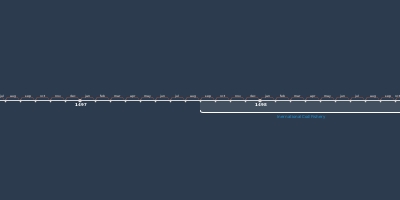Modern Piracy (1 ene 1985 año – 10 h 31 m, 14 jul 2025 año)
Descripción:
Modern piracy mainly occurs off the coasts of Africa and the China Sea. From 1985-2011 there is a steady incline, with a decline beginning around 2011. Modern piracy mostly consists of small speed boats trying to take ships by surprise. There is a pirate attack once every few days, with hot spots being in India, Shri Lanka, and Indonesia. The Strait of Malacca and the South China Sea are where 1/3 of all pirate attacks occur. The main target in these attacks are large ships, tanks, and bull carriers. 1/3 of the world's oil production passes through this water, and their slow movement makes them more vulnerable to attack. Attacks seemed to have increased after WW2, due to a number of reasons: smaller navies, shrinking resources and defense budgets, technology, failed states, lack of regulation on the seas, and lack of international cooperation.In response to this, Western nations refused to pay ransoms, as it was enabling and would keep coming back. There was a saying that one pirate and a million dollars equals one million pirates, but that one pirate and one bullet equals one less pirate. The lack of resources against piracy will continue to let it thrive, since global trade has thrived since the cold war. China has become a marketplace since the mid 90s and 96% of the world's export are carried by ship. The official decrease in piracy does not mean much, just that less are reported due to a cost/benefit system. It can cause 50-80 million dollars to reroute a ship, while the average ransom is 3 million. Many shipping companies do not report when a ransom is payed as it could delay shipping and drive up insurance rates. In the 1500s to 1860s, the manning ratios of ships was 5-18 tons per man, with 150-700 tons on board. However, from the 1860s to 2000s, this increased to 5k-6k tons per man and 24k tons on board. There are fewer men on ships now.
There are many myths that now surround piracy, one of them being motivation. Why be a pirate? It could be for economic or political motivation, freedom from an oppressive government, revenge, or from an outcast status (criminals, slaves, lunatics).
Another myth is that pirates were not racist. This is debunked as many pirates participated in slave trades, and the variance in race on ships had more to do with desperation sprouting from pardons and pirate hunts. We also simply want to project our concerns on the time.
There is a myth that pirates worked on a democratic system. This is partially accurate, as pirate societies were more democratic than their home governments. The captain was not always a tyrant, and if a captain was not successful, they would have an election to replace him as leader. Many leaders such as Black Bart even had contracts, and everyone got a fair split of the prizes/provisions.
Because of this, pirate life is seen as a Utopian society, with examples of pirate havens like New Providence. They are see as Utopian as there are no social or class divisions, but this is not the case. They believed in private property and were not Robin Hood figures. They did not care about the poor or want peace on Earth.
The most popular pirate myth has to do with buried treasure. This started because of William Kidd, who buried his loot before his execution.
Añadido al timeline:
fecha:
1 ene 1985 año
10 h 31 m, 14 jul 2025 año
~ 40 years
